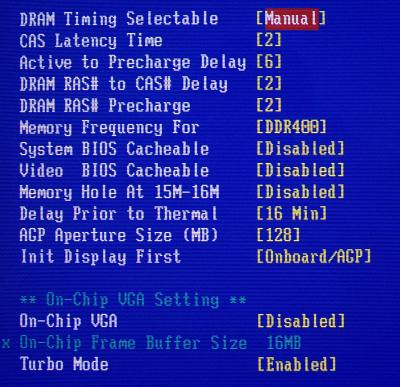BIOS
Recent XPC BIOSes have been anything but boring. If anything, they've been just as tweakable as any full-size board's. The BIOS was updated to the FB61RS06 (17/11/03) before testing.
Classic Phoenix AwardBIOS. It's easy to navigate and simple to use. Our attention is immediately drawn towards the frequency / voltage section on the right.

Clock ratios will only present themselves if you're in possession of an unlocked CPU. Springdale boards have shown a tendency to hit 250FSB+ with utter stability. Shuttle now allows stepless FSB choices from 100 - 355MHz. That's not as crazy as it at first sounds. There's little point in allowing sky-high FSB clocks if sensitive buses cannot be locked to certain speeds. Shuttle allows AGP/PCI/SATA fixing at the default 66/33/100MHz, 73/36/100MHz and 80/40/100MHz. SATA bus clocks never change. We're more than happy to keep it at what's shown above.
Voltage-wise, the FB61 doesn't disappoint. 1.1v - 1.85v CPU voltage provides enough scope for enthusiasts. DDR voltage tops out at a reasonable 2.75v. We wonder why there's never been chipset voltage manipulation for Intel dual-channel-based motherboards.

Forget the FB61 as the motherboard that's housed inside a cute Shuttle's confines. It has all the options of its full-size brethren. HEXUS benchmarking uses default memory latencies of 2-2-2-6, helped by some excellent Corsair RAM. The i865G is designed foremost for the new-ish 200MHz FSB P4 CPUs (Intel will tell you 800MHz FSB), but it also supports every Socket-478 CPU currently available. Memory frequency is best run synchronous to the FSB, which is DDR400 in this case. One can also choose DDR320 and DDR266 if system RAM isn't quite up to the job. Onboard graphics have a maximum on-chip frame size of only 16MB.

Wireless support and FireWire connectivity are automatic, that is, they cannot be toggled on or off (the former can if you disable the USB controller). There's limited scope in the features' section. SATA support is available in another subscreen that allows the user to toggle between SATA IDE (independent) and RAID (self-explanatory) formats.

We're not sure why Shuttle refuses to adopt an automatic shut-off feature in the BIOS. Surely overheating inside a small case is of paramount concern. The Sunon fan's speed is governed by a number of settings which include 'Ultra Low', 'Low', 'Mid', 'Full' and 'Smart Fan'. The slowest setting is whisper-quiet in operation, with a fan speed of less than 2,000 RPM. Full speed hovers at around 3,500RPM. The Smart Fan feature intelligently controls the speed in relation to CPU temperature, and it can be set to speed the fan up at pre-selected temperatures, ranging from 40c - 80c. The fan will automatically engage full-speed mode if the CPU is deemed to have hit 80c. But what if the fan fails ?. We're also sceptical of Shuttle low CPU temperature reports. If a decent Thermaltake AX478 cannot keep the 3.2GHz P4 below 50c in a well-ventilated case, it's difficult to imagine the Shuttle I.C.E cooler doing the same.
Another robust, decent BIOS. Voltage levels are excellent, too.









